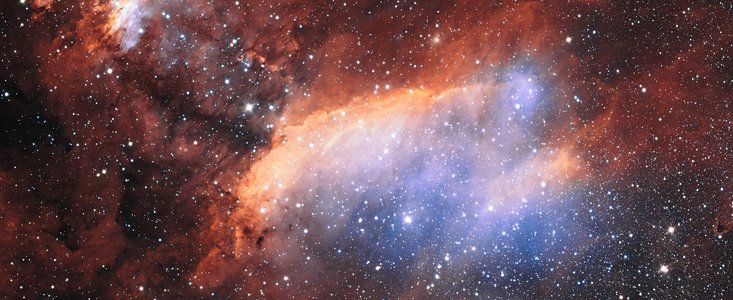Persbericht
Jonge sterren aan de kook in de Garnaalnevel
18 september 2013

De gloeiende wirwar van gaswolken op deze nieuwefoto maken een deel uit van een enorme stellaire kraamkamer die de bijnaam Garnaalnevel heeft gekregen. De opname, gemaakt met de VLT Survey Telescope van de ESO-sterrenwacht op Paranal in Chili, zou wel eens de scherpste kunnen zijn die ooit van dit object gemaakt. Hij toont grote aantallen hete pasgeboren sterren die in de nevel zijn ingebed.
De nevel, die formeel bekend staat als IC 4628, bevindt zich op een afstand van ongeveer 6000 lichtjaar van de aarde in sterrenbeeld Schorpioen. Hij bestrijkt een enorm gebied dat rijk is aan gas en opeenhopingen van donker stof. Zulke gaswolken zijn stervormingsgebieden, die heldere hete jonge sterren produceren. In zichtbaar licht vertonen deze sterren een blauw-witte kleur, maar ze zenden ook intense straling uit in andere delen van het spectrum – met name in het ultraviolet [1].
Het is dit ultraviolette sterlicht dat de gaswolken aan het gloeien brengt. Deze straling maakt elektronen los van waterstofatomen, die zich later weer combineren en energie afgeven in de vorm van licht. Bij dit proces zend elk chemisch element licht met een karakteristieke kleur uit, en bij waterstof is dat voornamelijk rood licht. IC 4628 is een voorbeeld van een HII-gebied [2].
De Garnaalnevel heeft een middellijn van ongeveer 250 lichtjaar en lijkt vanaf de aarde een oppervlak te beslaan dat vier keer zo groot is als de volle maan. Ondanks deze enorme omvang wordt hij door waarnemers vaak over het hoofd gezien, omdat het weinige licht dat hij uitstraalt wordt uitgezonden op golflengten waarvoor het menselijk oog niet gevoelig is. De nevel staat ook bekend als Gum 56, naar de Australische astronoom Colin Gum, die in 1955 een catalogus van HII-gebieden heeft gepubliceerd.
In de afgelopen paar miljoen jaar heeft dit hemelgebied vele sterren geproduceerd, zowel individueel als in groepen. Verspreid over een groot deel van deze foto is de grote sterrenhoop Collinder 316 te zien. Deze losse samenscholing van sterren maakt deel uit van een veel grotere verzameling van zeer hete en heldere sterren. Ook te zien zijn vele donkere structuren of holten, waar interstellaire materie is weggeblazen door de krachtige winden van de naburige hete sterren.
Deze foto is gemaakt door de VLT Survey Telescope (VST) van de ESO-sterrenwacht op Paranal in Chili. De VST is de grootste telescoop ter wereld die ontworpen is voor hemelsurveys in zichtbaar licht. Het is een geavanceerde 2,6-meter telescoop, gebouwd rond de camera OmegaCAM, die 32 ccd-detectoren waarmee 268-megapixel opnamen kunnen worden gemaakt. Deze nieuwe 24.000 pixels brede foto is een mozaïek van twee van dergelijke opnamen en een van de grootste foto’s van één object die ESO tot dusver heeft uitgebracht.
De foto maakt deel uit van een gedetailleerde survey van een groot deel van de Melkweg, VPHAS+ geheten, die gebruik maakt van de kracht van de VST om nieuwe objecten te ontdekken zoals jonge sterren en planetaire nevels. De survey zal ook de beste opnamen opleveren die tot nu toe van veel grote gloeiende stervormingsgebieden zijn gemaakt.
De zeer scherpe VST-opnamen zijn bewerkt door Martin Pugh, een zeer ervaren amateur-astronoom uit Australië die waarnemingen doet met een 32-centimeter en een 13-centimeter telescoop [3].
Dit persbericht is een mijlpaal – het is het duizendste persbericht van ESO. Het eerste verscheen eind 1985 en bevatte een foto van de komeet Halley. Alle berichten zijn online beschikbaar.
Contact
Richard Hook
ESO, Public Information Officer
Garching bei München, Germany
Tel: +49 89 3200 6655
Mob: +49 151 1537 3591
E-mail: rhook@eso.org
Rodrigo Alvarez (press contact België)
ESO Science Outreach Network
en Planetarium, Royal Observatory of Belgium
Tel: +32-2-474 70 50
E-mail: eson-belgië@eso.org
Over dit bericht
| Persberichten nr.: | eso1340nl-be |
| Naam: | IC 4628 |
| Type: | Milky Way : Nebula : Type : Star Formation |
| Facility: | Very Large Telescope |
Our use of Cookies
We use cookies that are essential for accessing our websites and using our services. We also use cookies to analyse, measure and improve our websites’ performance, to enable content sharing via social media and to display media content hosted on third-party platforms.
ESO Cookies Policy
The European Organisation for Astronomical Research in the Southern Hemisphere (ESO) is the pre-eminent intergovernmental science and technology organisation in astronomy. It carries out an ambitious programme focused on the design, construction and operation of powerful ground-based observing facilities for astronomy.
This Cookies Policy is intended to provide clarity by outlining the cookies used on the ESO public websites, their functions, the options you have for controlling them, and the ways you can contact us for additional details.
What are cookies?
Cookies are small pieces of data stored on your device by websites you visit. They serve various purposes, such as remembering login credentials and preferences and enhance your browsing experience.
Categories of cookies we use
Essential cookies (always active): These cookies are strictly necessary for the proper functioning of our website. Without these cookies, the website cannot operate correctly, and certain services, such as logging in or accessing secure areas, may not be available; because they are essential for the website’s operation, they cannot be disabled.
Functional Cookies: These cookies enhance your browsing experience by enabling additional features and personalization, such as remembering your preferences and settings. While not strictly necessary for the website to function, they improve usability and convenience; these cookies are only placed if you provide your consent.
Analytics cookies: These cookies collect information about how visitors interact with our website, such as which pages are visited most often and how users navigate the site. This data helps us improve website performance, optimize content, and enhance the user experience; these cookies are only placed if you provide your consent. We use the following analytics cookies.
Matomo Cookies:
This website uses Matomo (formerly Piwik), an open source software which enables the statistical analysis of website visits. Matomo uses cookies (text files) which are saved on your computer and which allow us to analyze how you use our website. The website user information generated by the cookies will only be saved on the servers of our IT Department. We use this information to analyze www.eso.org visits and to prepare reports on website activities. These data will not be disclosed to third parties.
On behalf of ESO, Matomo will use this information for the purpose of evaluating your use of the website, compiling reports on website activity and providing other services relating to website activity and internet usage.
Matomo cookies settings:
Additional Third-party cookies on ESO websites: some of our pages display content from external providers, e.g. YouTube.
Such third-party services are outside of ESO control and may, at any time, change their terms of service, use of cookies, etc.
YouTube: Some videos on the ESO website are embedded from ESO’s official YouTube channel. We have enabled YouTube’s privacy-enhanced mode, meaning that no cookies are set unless the user actively clicks on the video to play it. Additionally, in this mode, YouTube does not store any personally identifiable cookie data for embedded video playbacks. For more details, please refer to YouTube’s embedding videos information page.
Cookies can also be classified based on the following elements.
Regarding the domain, there are:
- First-party cookies, set by the website you are currently visiting. They are stored by the same domain that you are browsing and are used to enhance your experience on that site;
- Third-party cookies, set by a domain other than the one you are currently visiting.
As for their duration, cookies can be:
- Browser-session cookies, which are deleted when the user closes the browser;
- Stored cookies, which stay on the user's device for a predetermined period of time.
How to manage cookies
Cookie settings: You can modify your cookie choices for the ESO webpages at any time by clicking on the link Cookie settings at the bottom of any page.
In your browser: If you wish to delete cookies or instruct your browser to delete or block cookies by default, please visit the help pages of your browser:
Please be aware that if you delete or decline cookies, certain functionalities of our website may be not be available and your browsing experience may be affected.
You can set most browsers to prevent any cookies being placed on your device, but you may then have to manually adjust some preferences every time you visit a site/page. And some services and functionalities may not work properly at all (e.g. profile logging-in, shop check out).
Updates to the ESO Cookies Policy
The ESO Cookies Policy may be subject to future updates, which will be made available on this page.
Additional information
For any queries related to cookies, please contact: pdprATesoDOTorg.
As ESO public webpages are managed by our Department of Communication, your questions will be dealt with the support of the said Department.






